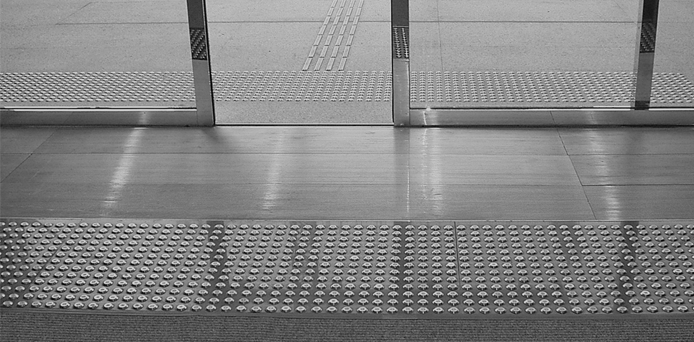Tactile indicator studs are an essential tool for ensuring pedestrian safety in busy or slip-prone areas. They also help anyone who is blind or visually impaired to navigate the world; by warning people when they are approaching a hazardous situation, such as stairs or a train platform, as well as providing directional cues for getting around in public spaces.
When it comes to installing tactile indicator studs, compliance is extremely important for safety, and ensures that visually impaired people get consistent information about their surroundings.
Incorrect installation or maintenance not only puts people’s safety or lives at risk, but also opens your business up to a host of legal and financial liabilities around OH&S compliance, as well as discrimination against people with disabilities.
If you’re working with a client on tactile indicators installation, we’ve put together a guide to ensuring your tactile indicators meet Australian Standards.
Where to install tactile indicator studs
Tactile indicator studs come in two formats – studded for hazards, and ribbed for directional guidance – which serve as a universal navigation language for those who are blind or visually impaired.
Hazard studs
Hazard studs must be used to warn of any potential hazards in public spaces or workplaces, including spots where someone’s life could be at risk from a fall or impact, such as the edge of a train platform, the entrance/exit of a carpark or driveway, or at the top and bottom of stairs, ramps and escalators.
Directional Tactiles
On the other hand, directional tactiles should be used as a guidance tool in open spaces, at intersections with slip-lane crossings, or for mid-block crossings with bus or tram stops.
For more information on where to use tactile indicator studs, take a look at our blog post here.
A 5 step tactile stud installation guide
To ensure those who are visually impaired have safe and dignified access to buildings and public spaces, as well as promoting wider public safety, tactile studs have to be consistent in the way they are used. This way, people know exactly when to expect a hazard or which direction to travel in, and can get around independently.
Because of this, the installation of tactile studs is regulated by multiple Australian bodies, including the Building Code of Australia, the Australian and New Zealand Design Standards for Access and Mobility (AS1428.4), and the Disability Discrimination Act.
According to the AS1428.4, tactile indicators have to be compliant for size, placement, and contrast. Follow the below steps to ensure your indicators meet the mark.
1. Get involved as early as possible in the design and construction process.
Accessible and safe design works best when it is incorporated early on into the construction process, as studs have to be installed within a certain distance of hazards, and need to meet certain size and contrast requirements. Different types of studs also need to be used for different surfaces – so the earlier these considerations are taken into account, the smoother the installation process.
2. Measure the placement of your studs.
Tactile studs provide a consistent message for those with visual impairments or those who are blind, so it’s important that their layout and location is consistent across all public spaces and buildings.
Tactile studs need to be set back at least 300mm +/-10mm from a hazard (such as the top of a set of stairs or ramps), so people have plenty of time to anticipate, and know when to expect, a hazard. They also need to have a minimum depth of 600mm in most applications to make persons aware of potential hazards.
Use Latham’s simple solid aluminium installation templates to make the location and installation process so much easier.
3. Ensure you have the correct tactile indicators layout.
Tactile studs have to be raised from the ground so they can be felt underfoot or by a cane, but not so high that they can cause people to trip over.
On top of this, the size of each unit and the spacing between them has to be consistent, to ensure there is no confusion or misinterpretation. When measuring, studs must be installed at 50mm +/-1mm centres.
4. Check your tactile studs meet the luminance contrast requirements.
To ensure people don’t trip on tactile indicator studs, they need to meet luminance contrast requirements - so studs stand out against the base surface.
In-line with Australian Standards, Discrete studs should have a minimum of 45% luminance contrast against their surrounding floor or ground surface (for example, yellow tactiles against a dark surface), whilst two colour Discrete Tactile Studs should achieve 60% luminance contrast.
Use a tactile stud supplier with a range of colours, so you can choose those that have the best contrast for your surface. Ask if they are able to test and certify the luminance contrast of tiles.
5. Consider the external conditions where the studs are being used.
Tactile studs often have to endure harsh conditions, particularly in wet weather conditions. As a result studs need to meet slip resistance requirements to prevent any accidents, no matter what type of material they are made from.
It’s also important to choose studs that are high quality, both in terms of materials used and installation method. Tactile studs are exposed to UV, foot traffic, and extreme weather conditions, which means over time poor quality studs can lose their luminance contrast, or fall off and cause tripping hazards.
Choose high quality studs with a stem attached so they are strongly secured and won’t fall off after a few weeks of use – this way, your business reduces any OH&S risks and your studs last longer.
Whether it’s hazard studs or directional cues, tactile indicator studs are important to give blind or visually impaired people safe and independent access to the world around them. Latham’s premium tactile indicator stud range is compliant with AS1428.4-2009, and is designed to withstand wear and tear for long lasting use. Get a copy of our safety stair and flooring catalogue by clicking the image below.
To find out more about Latham products, please visit www.latham-australia.com. To talk to a Latham product expert, call 1300 LATHAM (528 426) or email sales@latham-australia.com.


